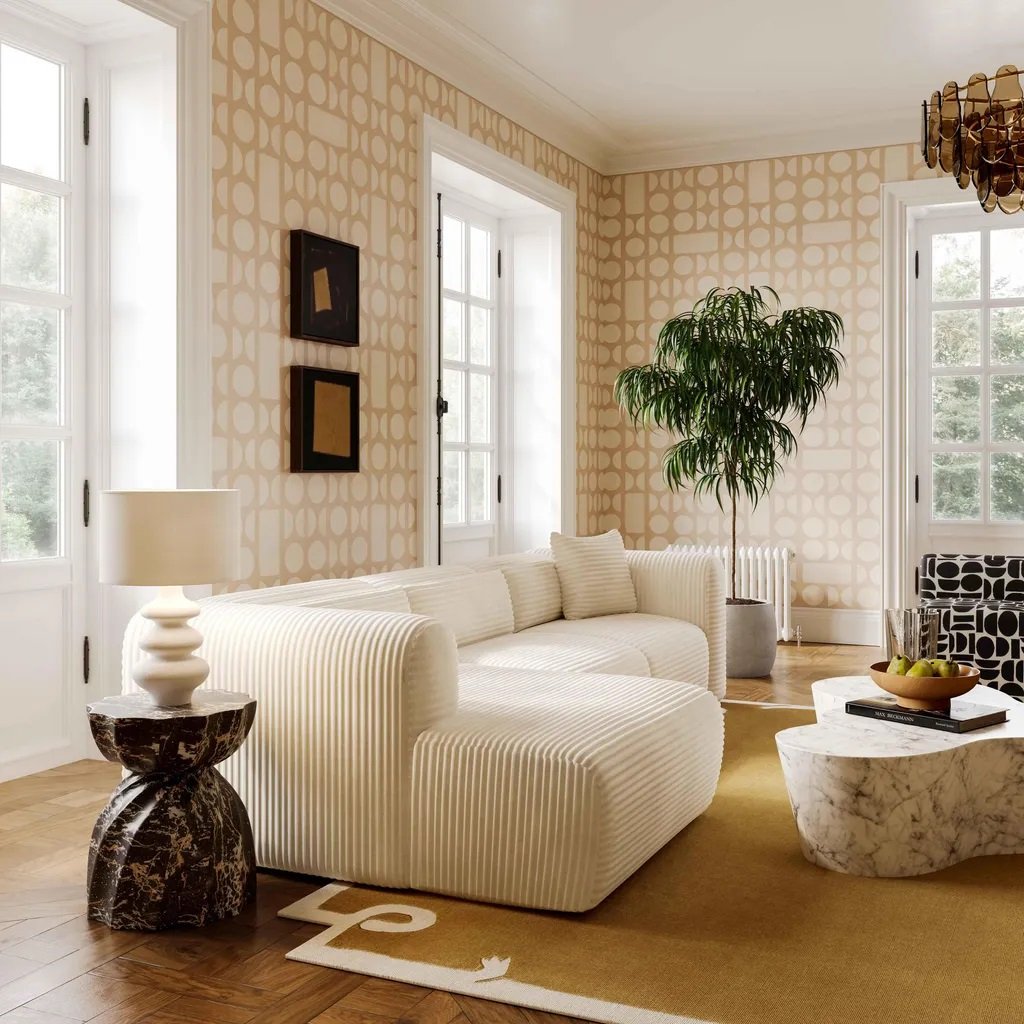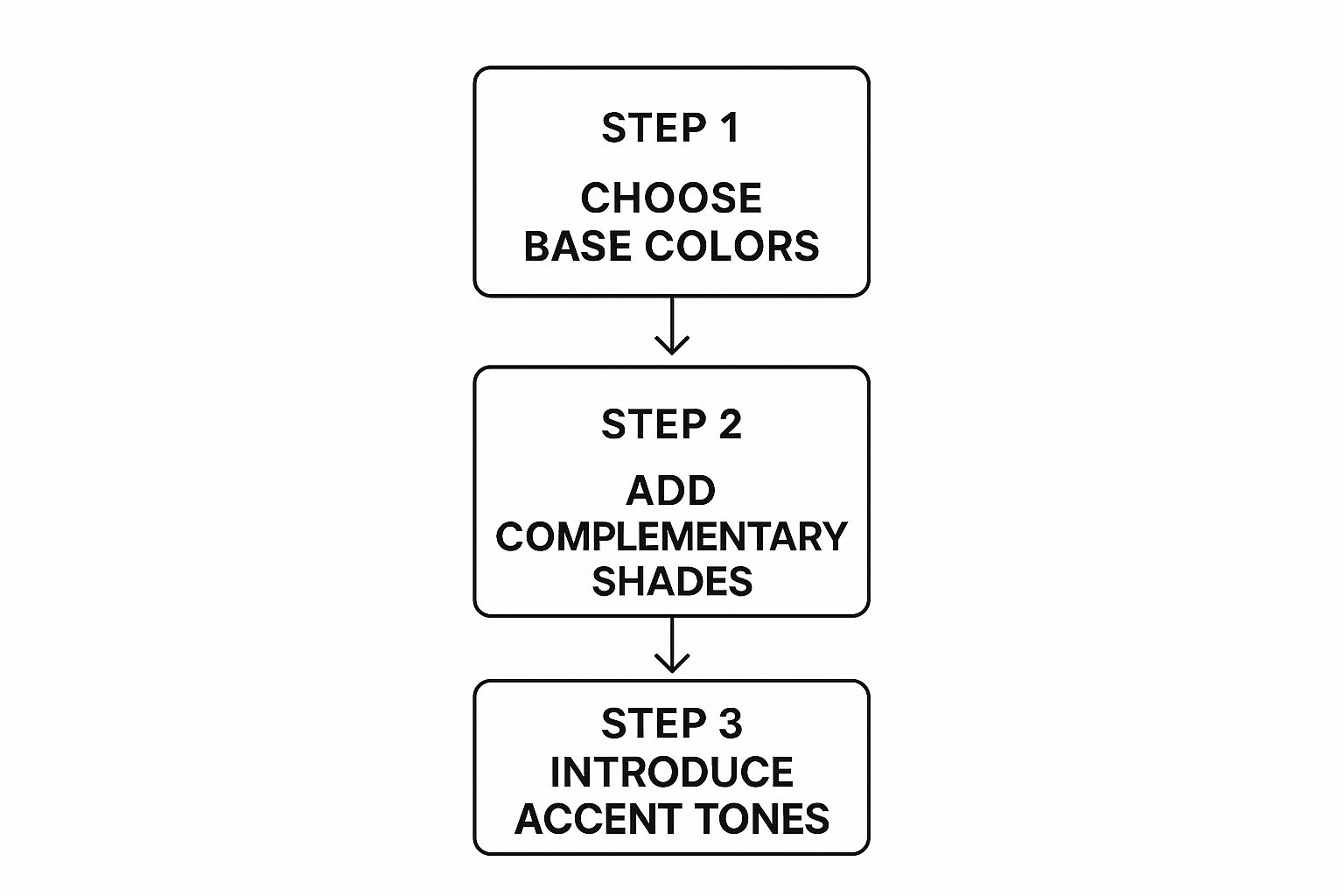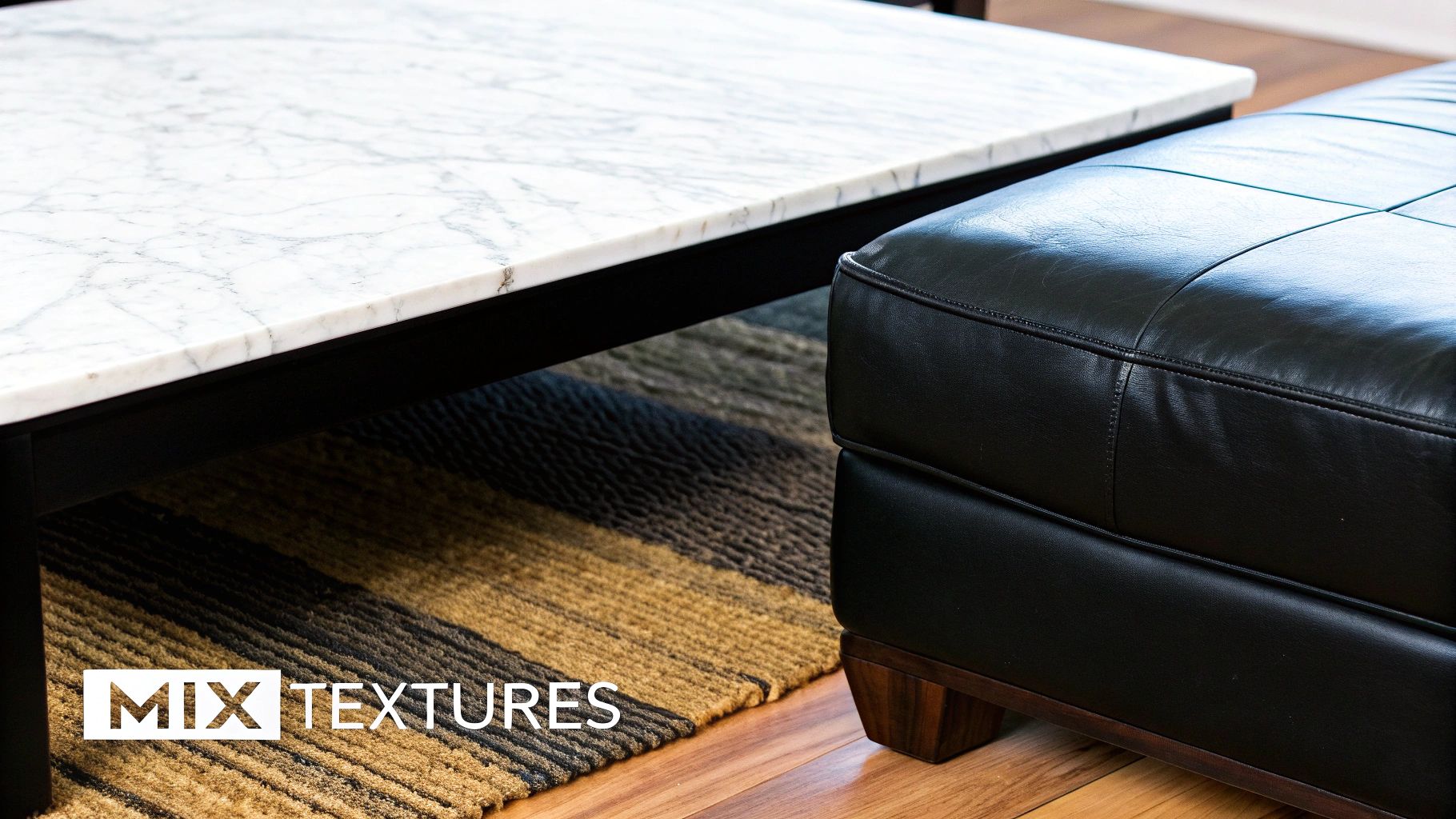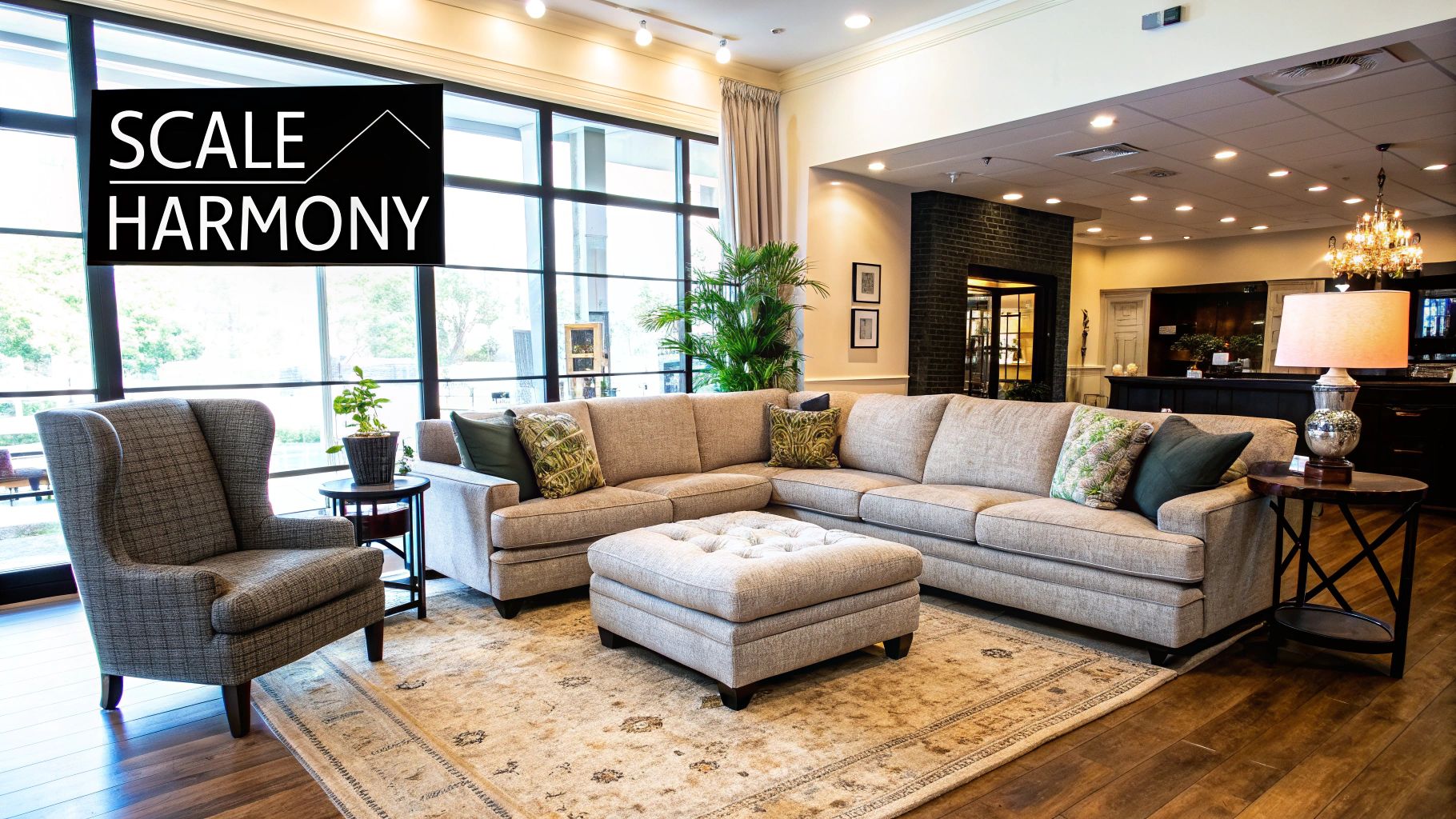
How to Mix Furniture Styles Without the Chaos
Share
Learning how to mix and match furniture is all about finding that one common thread—maybe it's a color, a particular shape, or even a texture—that pulls everything together. When you get it right, the result is a room that feels intentionally stylish, not like a chaotic jumble of random pieces. It really just comes down to a few key ideas, and once you get the hang of them, you can start blending styles with confidence to create a space that’s truly you.
The Secret to Blending Furniture Styles
Let's just throw out that old-fashioned rule that says everything in a room has to match perfectly. Honestly, a space filled with a coordinated furniture set can feel a bit sterile and impersonal, almost like you’re living in a page from a catalog instead of a home that tells your story.
The real art of interior design is creating a home that feels like it’s been collected over time. It’s about layering pieces you absolutely love, no matter what their style labels say.

When you mix furniture styles, you’re adding character and depth, making the room feel more dynamic and visually interesting. The goal isn’t just to fill a space; it’s to curate an environment that’s a direct reflection of who you are. This is what gives you the freedom to pair a sleek, modern sofa with a vintage armchair you found at a flea market, or an industrial coffee table with a rustic console.
Why Mixing Styles Just Works
Combining different aesthetics tells a story. It breathes personality into a room, and when you do it with a bit of thought, the space instantly feels more authentic and inviting. The secret is simply making sure the mix feels purposeful.
Here’s why blending furniture styles is such a great approach:
-
It’s a form of self-expression. You get to show off your personality and unique tastes without being boxed into a single design trend.
-
It creates a timeless look. A mix of styles is much harder to date than a room that screams "2024 trend," giving your home much longer-lasting appeal.
-
It’s budget-friendly. This is the perfect way to incorporate pieces you already own, family heirlooms, or cool thrift store finds right alongside new purchases.
This whole design philosophy has gone completely mainstream. It's a big shift, and you can see it reflected in the global furniture market, which was valued at USD 568.60 billion in 2024. According to Fortune Business Insights, it’s expected to keep growing, largely driven by people like us wanting innovative designs that blend different looks.
A well-designed room should feel like it was assembled over time, with pieces that have a history and a future. The most beautiful interiors are those that tell the story of the people who live in them.
Getting Started With Confidence
The whole idea of blending styles might feel a little intimidating at first, but it really doesn't have to be. If you focus on a few foundational principles—like establishing a consistent color palette, balancing the scale and proportion of your pieces, and repeating certain elements—you can create a look that feels completely harmonious.
For instance, just exploring a curated selection of pieces, like those in our collections, can spark ideas and help you find items that naturally complement each other, even if they're from different "style families."
To make it even simpler, here's a quick-reference table that breaks down the core techniques.
Core Principles for Mixing Furniture Styles
|
Technique |
What It Means |
Example |
|---|---|---|
|
Consistent Color Palette |
Using a limited set of colors (e.g., 3-5) to tie different pieces together visually. |
A blue velvet Art Deco chair and a modern gray sofa work together in a room with blue and gray accent pillows. |
|
Balance Scale & Proportion |
Ensuring furniture pieces are appropriately sized for the room and for each other, creating visual balance. |
A large, chunky farmhouse table is balanced by delicate, minimalist chairs instead of equally bulky ones. |
|
Repeat Elements |
Repeating a specific shape, material, or texture throughout the room to create a sense of rhythm and cohesion. |
The black metal legs on an industrial coffee table are echoed in the black frames of your artwork and a modern floor lamp. |
|
The 80/20 Rule |
Let one style dominate (80% of the room) and use a secondary style for accent pieces (20%). |
A mostly Scandinavian room (light woods, neutral colors) features a few bold, ornate Victorian-era accent pieces. |
Ultimately, mixing styles is about creating a beautiful sense of balance and finding those surprising connections between seemingly different items. This guide will walk you through the principles and give you the confidence you need to start experimenting and turning your space into a true reflection of you.
Find Your Anchor Style And Its Partner
Ever walk into a room that feels like it’s singing in harmony? The secret lies in choosing one furniture style that sets the mood—and then letting every other choice riff off it. This anchor style becomes your design’s north star, grounding the space without chaining you to a single look.
To discover your anchor, flip through magazines, bookmark Instagram posts, or create a quick mood board. Notice recurring shapes, colors, and textures—those are clues pointing to your primary style.
Maybe you’re smitten by the sleek curves of Mid-Century Modern or you crave the warm embrace of a rustic farmhouse. Whatever your heart settles on, this main style shapes the room’s character and ensures every piece that follows feels deliberate.
The 80/20 Rule For Mixing Styles
Once your anchor is in place, bring in a sidekick. Think of it as a flavor enhancer rather than a competing ingredient. The 80/20 rule is a handy guide—aim for 80% of your space to showcase the primary style, with the remaining 20% reserved for a secondary one.
This simple ratio prevents your design from feeling disjointed. The smaller portion acts like a pop of unexpected color or texture, giving life and personality without overwhelming the base.
For instance, if a French Country palette with soft whites and curved lines is your anchor, a dash of Bohemian flair—like a woven hanging lamp—can be your accent. Or pair a sleek Art Deco sofa with a rustic wooden ladder that drapes throws for a touch of lived-in charm.
Putting It Into Practice
Imagine your anchor is a clean-lined modern sofa. That sofa tells everyone how the room should feel—crisp, uncluttered, perfectly edited. To nail down your main piece, I often browse modern and transitional sofas and pick one that speaks to both my style and lifestyle.
Then comes the fun part: layering in the partner style. If you want to bring in some organic warmth, consider:
-
A reclaimed wood coffee table—complete with knots and grain that whisper stories.
-
A handwoven jute rug—textured and earthy underfoot.
-
Ceramic vases or linen throw pillows—simple, imperfect, and soft.
-
Black metal floor lamp—for a subtle industrial twist.
-
Framed graphic artwork—to tie in bold lines with minimalist furniture.
These accents create tension against those straight modern lines, giving every glance a fresh discovery.
Your partner style shouldn't compete—it should converse. Aim for pieces that highlight your anchor’s strengths rather than steal the spotlight.
To visualize it another way, here’s how the concept breaks down:
|
Aspect |
Anchor Style (80%) |
Partner Style (20%) |
|---|---|---|
|
Color Palette |
Neutral tones, soft pastels |
Bold accents, rich hues |
|
Materials |
Light wood, leather |
Metal, rattan |
|
Forms |
Streamlined, minimal |
Textured, organic |
Test it before you commit. Swap in one accent piece for a few days and see how it feels at different times of day. This hands-on trial avoids big regrets and ensures those 20% picks truly sing.

With your anchor setting the scene and your partner adding personality, every design choice follows a clear roadmap. This method keeps things fresh, intentional, and uniquely yours.
Use a Unifying Color Palette to Create Harmony
If you're wondering how to pull off a mixed-style room, color is your secret weapon. Seriously. It’s the invisible thread that can stitch a formal Victorian armchair to a minimalist side table, making the whole space feel intentional and pulled together. Without a cohesive color story, even the most beautiful, high-end pieces can just feel like a chaotic jumble.
Think of your room’s color palette like a simple recipe. You don’t need a dozen competing ingredients. A carefully chosen handful will create a much more memorable, sophisticated flavor.

This approach is more relevant than ever. Homeowners are moving away from cookie-cutter looks and embracing personalized interiors. In fact, the bespoke furniture market was valued at a whopping USD 35.47 billion in 2023 and is only expected to grow. People want unique spaces that reflect who they are, and color is the key to making those personal mixes work beautifully.
Building Your Cohesive Color Scheme
The first step is to pick a simple palette of three to five colors. That's it. This constraint forces you to be deliberate and keeps the room from feeling visually overwhelming. Your palette should have a main color, a secondary one, and a couple of accents for a little pop.
Here’s a simple rule of thumb I always use:
-
Primary Color (60%): This is your big-ticket color. It's usually on the walls or the largest furniture piece, like your sofa. A good neutral like a warm white, soft gray, or a creamy beige works wonders here.
-
Secondary Color (30%): This color plays a supporting role. You'll see it on pieces like accent chairs, curtains, or a large area rug.
-
Accent Colors (10%): These are your moments of surprise. Think vibrant, eye-catching hues used sparingly on throw pillows, artwork, vases, or a statement lamp. They're what guide your eye around the room.
Color doesn't just tie things together; it tells a story. A well-chosen palette can make a room feel calm and serene or energetic and bold, all while making your eclectic furniture choices look like they were meant to be together.
Let's make this real. Say you have a traditional navy velvet armchair that you absolutely love. To make it feel at home next to a very contemporary, light oak coffee table, you could hang a modern abstract painting above the sofa that picks up that same shade of deep blue. Just like that, you've created an immediate visual link.
Using Textiles to Bridge the Gap
Textiles are your best friends for weaving your color palette through a room. They’re an easy and often affordable way to sprinkle your chosen hues around, connecting otherwise disparate pieces.
Think about it: a vintage leather sofa and a sleek metal side table can suddenly feel like a perfect pair when they’re grounded by a rug that incorporates tones from both. It’s a classic designer trick.
Consider these simple strategies:
-
Toss throw pillows on a modern sofa that pull a color from a nearby vintage armchair.
-
Find a patterned rug that includes all the main colors in your palette.
-
Hang curtains that echo a secondary color you've used in your accent furniture.
By strategically repeating colors through paint, textiles, and decor, you create a visual language that makes your mixed-style room feel harmonious and expertly curated. If you're looking for the perfect starting point, our guide has some stunning paint colors that can revolutionize your decor.
Balance Scale, Shape, and Texture for Visual Flow
Once you've got your color palette down, the real artistry begins. This is where we get into the details that make a mixed-style room truly sing—balancing visual weight, creating rhythm with shape, and adding depth through texture.
It’s not just about the individual pieces you choose, but how they talk to each other in the space.
Think of your room like a seesaw. If you put a heavy, ornate antique chest on one side, the other side needs something to create a sense of equilibrium. You could pair it with a couple of light, airy modern chairs with thin metal legs. That contrast is what keeps the room from feeling lopsided and creates a dynamic, engaging feel.
Play with Visual Weight and Scale
Visual weight isn't about how many pounds something weighs; it's about how heavy it feels to your eyes. A dark, solid wood armoire feels substantial, while a glass coffee table with delicate legs feels light. The secret is to spread this weight around the room evenly.
For example, if you have a big, traditional sofa with a skirt that goes all the way to the floor, try balancing it with accent chairs that have exposed legs. This simple trick opens up the space, preventing the room from feeling anchored in one spot and letting the eye move around more freely. We dive deeper into this in this guide on how to arrange living room furniture.
This same principle is a big reason why multifunctional furniture is so popular right now. As our living spaces get smaller, we need pieces that can do more without overwhelming a room. The global market for this stuff was valued at around USD 12.8 billion in 2023 and is expected to hit USD 21.7 billion by 2032. These pieces are often masters of balance, mixing sleek modern forms with traditional materials to look good and work hard.
Repeat Shapes to Create Rhythm
Here’s a subtle but incredibly powerful way to tie different styles together: repeat shapes. Look for common lines and silhouettes across your furniture and decor.
Does your classic armchair have a gently curved back? Echo that same curve with a modern arc floor lamp or a round side table. This repetition creates a quiet rhythm that your brain picks up on, making the whole mix feel intentional and not just a random collection of things.
Think about pairing shapes like this:
-
Curves: Match the rounded arms of a traditional sofa with a circular mirror or a curved-back dining chair.
-
Straight Lines: The clean, angular lines of a modern media console can be echoed in the frame of abstract art or the straight legs of a Mid-Century chair.
By repeating a silhouette, you're creating a visual conversation between pieces from different eras. It's the secret language that makes your eclectic mix feel cohesive and thoughtfully curated.
Layer Textures for Depth and Interest
Finally, let's talk texture. Texture is what keeps a room from feeling flat and one-dimensional. A space filled only with smooth, shiny surfaces can feel a bit cold and sterile. Mixing in a variety of textures adds richness and makes you want to reach out and touch things.
The goal is to create compelling contrast. Here are a few combinations that almost always work:
-
A smooth, cool marble tabletop next to a soft, warm velvet sofa.
-
A rough, natural jute rug under a sleek leather accent chair.
-
A rustic, reclaimed wood dining table paired with smooth, molded acrylic chairs.
These textural layers add a sophisticated depth, making your design feel rich and considered. When you get the hang of balancing weight, repeating shapes, and layering textures, you’ve moved beyond just picking pretty things. You’re crafting a space that feels truly harmonious and uniquely yours.
Blend Different Eras and Materials with Confidence
That antique wingback chair you inherited from your grandmother doesn't have to be exiled to the garage. The secret to a truly personal and captivating room often lies in the artful mix of furniture from different decades—and even centuries. It's about building a conversation between your pieces, not having them scream at each other from across the room.
Think of it this way: you’re creating a space with a story.

This is where your unique style can really shine. A fantastic way to give a vintage piece a new lease on life is by changing its upholstery. Imagine that classic chair, with its beautiful ornate legs, suddenly wrapped in a bold, contemporary geometric fabric. You’ve instantly honored its history while making it feel completely current.
The same goes for materials. Don't be afraid to create some delicious contrast. A rustic, live-edge wooden dining table paired with sleek, industrial metal chairs? Stunning. The organic warmth of the wood beautifully balances the cool, clean lines of the metal, creating a dynamic tension that makes the whole setup feel intentional and interesting.
Create Connections with Bridge Elements
When you're mixing distinct styles, you sometimes need a "bridge" to connect them. Think of these as mediator pieces that share characteristics with multiple items in the room, creating a subtle link that helps everything feel cohesive.
Artwork and mirrors are absolute masters at this. A big, ornate gilded mirror—a definite nod to traditional design—can look incredible hanging over a minimalist, modern console table. The mirror’s classic frame adds a layer of history, but its reflective surface feels bright and contemporary, tying the two worlds together effortlessly.
The most interesting rooms are the ones that don't subscribe to a single design rulebook. They feel authentic because they’ve been curated over time, blending sentimental heirlooms with contemporary finds.
Lighting is another powerful unifier. Instead of matching every lamp, try layering different styles to cast a warm, cohesive glow over the entire space. You could have an industrial-style arc floor lamp with a matte black finish curving over a cozy armchair, which has a traditional ceramic table lamp sitting right next to it. Each piece is distinct, but together they create a layered, functional, and visually rich environment.
Inspiring Furniture Style Combinations
To get your creative gears turning, it helps to see how these pairings work in practice. Here are a few combinations that consistently deliver stunning results, along with the key pieces that make them sing.
|
Style Combination |
Key Foundation Piece |
Complementary Accent Piece |
Unifying Element |
|---|---|---|---|
|
Modern & Rustic |
A sleek, low-profile sofa with clean lines and neutral upholstery. |
A reclaimed wood coffee table with visible knots and a natural finish. |
A jute rug and linen throw pillows that add organic texture to both pieces. |
|
Industrial & Mid-Century |
An exposed-leg Mid-Century Modern credenza in a warm walnut finish. |
Black metal-frame accent chairs or a factory-style pendant light. |
Repeating geometric shapes in artwork or textiles that echo the lines of both styles. |
|
Bohemian & Traditional |
A classic roll-arm sofa in a durable, light-colored fabric. |
A carved wooden side table from Morocco and a collection of potted plants. |
A vibrant, patterned Persian rug that incorporates colors found in both the sofa and boho accents. |
By thoughtfully combining eras, materials, and those all-important finishing touches, you can create a look that’s not just stylish, but feels completely and uniquely you.
Your Questions On Mixing Furniture Styles Answered
Even with a clear plan, you might pause mid-project, squint at your space, and wonder if it’s effortlessly curated or just cluttered chaos. That’s totally normal. Let’s clear up those nagging doubts so you can move forward with confidence.
What If A Piece Feels Too Formal Or Dated For My Space?
Inherited treasures often carry a sense of history—and sometimes, they feel out of step with your style. The good news? A little DIY magic goes a long way.
-
Give a dark, ornate breakfront a fresh coat of chalky white or soft gray to instantly lighten its presence.
-
Swap out an old upholstery for a sleek, modern fabric—linen or cotton canvas work wonders.
These small tweaks help a traditional piece blend into a contemporary setting without losing its charm.
What Do I Do With Gifted Furniture I Don’t Love
Sentiment can make you cling to pieces that don’t really fit. Start by checking the “bones.”
Is the frame sturdy? If so, a tailored slipcover in a neutral textile might be your best friend. Linen, cotton canvas, or a muted stripe can hide odd shapes and unify the sofa with the rest of your décor.
You don’t have to keep every piece just because it came with good intentions.
Letting go of something that doesn’t bring you joy frees up space for a piece you truly adore. A lean, well-curated room always feels more intentional than one crowded with filler.
How Can I Tell If My Room Looks Eclectic Or Just Messy
The difference hangs on one word: intention. When you mix styles thoughtfully, everything looks like it belongs. A random jumble, on the other hand, screams “last-minute grab.”
Use this quick checklist:
-
Consistent Color Story: Are three to five hues repeated in pillows, throws, and art?
-
Echoed Shapes: Does a curved lamp mirror the lines of an antique chair?
-
Balanced Scale: Have you paired heftier items with airier pieces to avoid heaviness in one corner?
If you tick off most of these, your room is leaning toward eclectic elegance. And if you’re still unsure? Try removing just one or two pieces—you’ll often see the design come into sharper focus.
Ready to discover standout items that tie your personal style together? At Fluent Trends, we handpick designer-approved furniture and decor that transform a house into a home. Explore our collection and find the finishing touches that tell your story.
Article created using Outrank
